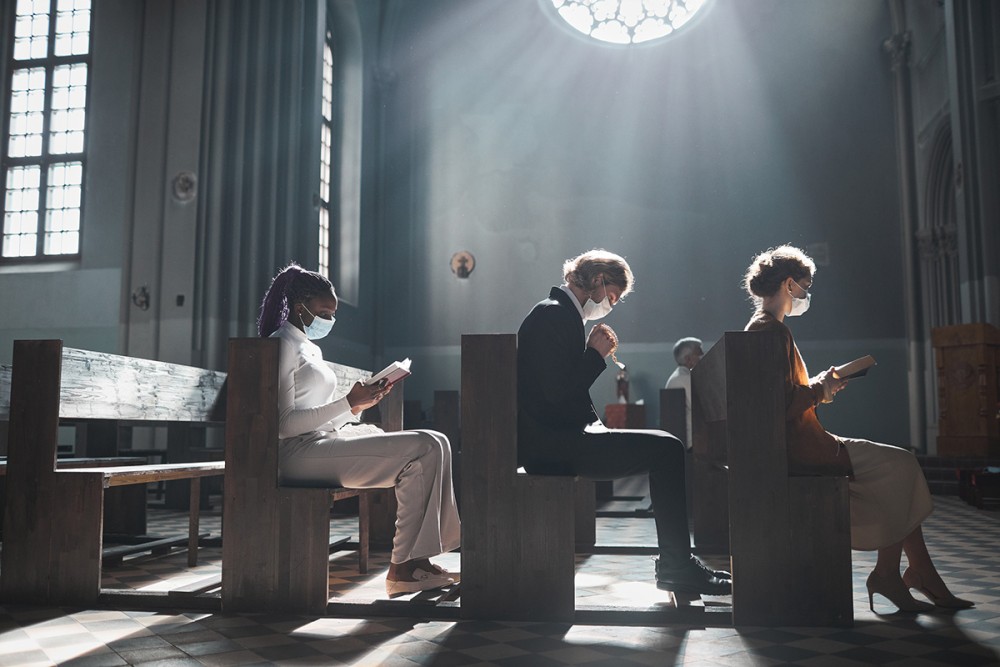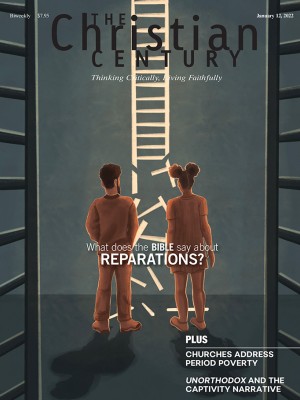A worship practice Zoom can’t replicate
Silence, in the Christian tradition, is a shared discipline as much as an individual one.

I’m a relatively new pastor, and most of my clerical life—all but two months—has been spent in the grip of the COVID pandemic. I’ve spent more time than I care to admit trying to mitigate the suspicions of corporate bodies in physical space. Are you sure this will give people six feet of distance? Looking at the numbers, should we delay the sacrament again this week?
These past months have also revealed the fragile core of the church’s life together. The nation has moved through cultural upheaval that demands the intimacy of proximity, and yet it has been nearly impossible to gather together. I’ve seen cruel words in emails that I never believed Christians could write. I’ve heard pastors, the progenitors of flourishing ministries, detail their excitement thinking about a career change. It’s hard to imagine that there’s no connection between the physical distance and the disenchantment of our time.
Read our latest issue or browse back issues.
Much of our nation’s religious practice has migrated online. Facebook has been partnering with a variety of denominations, including my own, to develop digital spaces for online worshipers. How are we being formed by these technologies? What do they make possible, and what do they make impossible? While many have debated the blessings and woes of digital worship, few have discussed the role of silence. Silence cuts against the grain of disembodied online chatter. A shared, instructive silence is one thing I’m convinced that Zoom cannot facilitate, not even with the mute button.
Silence is antithetical to most online interaction. Social media generates interest and revenue from our urge to speak. It implores us to talk and talk often. We derive social capital from witty or poignant posts that garner likes and responses. It’s common to describe a user’s passive, quiet participation on social media as “lurking,” demonstrating how silence is pathologized once speech has become normative. There is, we seem to believe, something devious and dissident about the quiet restraint that silence requires, especially when speech is so readily accessible.
In How to Do Nothing, Jenny Odell quotes acoustic ecologist Gordon Hempton: “Silence is not the absence of something but the presence of everything.” Odell thinks that the attention economy has convinced us that efficiency and urgency require constant speaking. It has made the kind of listening Hempton advocates for impossible. On our long walks and runs, there is always one more podcast we can siphon through our AirPods. Silence, on the other hand, is gratuitous because it assumes that everything we need is already available to us without additional words or sounds.
Anglican Church in North America priest Tish Harrison Warren recently raised some timely questions about the practice of contemplation in a political moment that can equate silence with inaction. The cultivation of “rich interior lives of prayer and stillness” that she invites feels to me like the lifeblood of faithful Christian social practice. Prayer and stillness, in the midst of social movement, offer individual moments of sabbath on the road to justice.
Yet silence, in the Christian tradition, is a corporate activity as much as an individual one. It is not just a private interlude before returning to the streets. It is an act of the church’s public and visible worship to seek the Spirit’s presence anew. Warren argues that bodies require silence. I’d maintain that silence also requires bodies.
I’d wager that the moment in a church service when we are most aware of the people around us is not during hymns or collective prayer. It’s when the pastor asks us to confess our sins in silence and then holds that silence for what seems like an eternity. “The deeper the silence, the more powerful the liturgy” has been the principle I’ve taken with me to every congregation: How long will they make us wince through the silent moments of the prayer of confession? How long will the pastor hold the bread and wine up before affirming, “The gifts of God for the people of God”?
Silence makes us acutely aware of the presence of others. It gives room for others to speak. It gives room for God to speak.
We must “distinguish between the mere absence of speech,” says philosopher L. M. Sacasas, “and what might properly be called silence.” Silence is about presence, not just absence. He goes on: “Silence is felt. It is meaningful. It is not mere negation.” It is a pregnant stillness that raises heart rates and releases endorphins within the pathways of our bodies. It is about the quiet friction between individuals gathered in space. It is that eerie awkwardness, when there is an excess of silence in a church service, that makes us notice the feeling of a neighbor’s presence. All this leads to my somewhat counterintuitive conclusion that without other people—without other bodies in space—silence is impossible.
Yet silence is cultivated, not simply given. Bodily silence is a kind of shared discipline; my silence is incomplete without another’s. During the prayer of confession, the silence is contingent on each individual member of the church body keeping that silence. Because it is shared, it is instructive. In some small way, it teaches us about mutual forbearance, respect, and collective wholeness.
I am a Presbyterian, and Presbyterians have often shied away from subjects like silence. Our Reformed heritage has made us people of the spoken word, preached and proclaimed. And yet, some of Christ’s most breathtaking moments in the Gospels are wordless ones. Standing before Pilate, his refusal to speak is also a refusal to recognize Pilate’s power over life and death. His wordlessness speaks louder than any words could. Christ’s political impotence is flipped on its head, and in that moment his incarnate, physical presence won’t shrink to the demands made by his adversary. His silence is where, as Rowan Williams puts it, the mystery of God becomes most present—a mystery greater than Pilate’s state power.
X González taught us something about the strength, imagination, and mutuality hidden in our collective speechlessness. At the March for Our Lives in 2018, the gun-control activist was assigned the last in a litany of speeches. Political rallies tend to be places of noise and constant speech. But after speaking to the horrors that they had witnessed, González did something no one expected: they shut their eyes and simply held the quiet. Seconds passed, then minutes, and tears began to fill their eyes. They remained on stage without uttering a word until a timer notified them that 6 minutes and 20 seconds had passed—the amount of time the shooter had been active at the Parkland, Florida, school shooting earlier that year, which González survived.
Like Christ’s refusal to placate Pilate with an answer, González’s silence infused their person, their story, and their cause with more potency than words could have. Many in the audience, perhaps confused, couldn’t bear to hold the stillness with them, and they shouted and verbally affirmed their support of them. Yet empathy and imagination grew in the quiet of the moment. The stillness was beautiful not just because it was politically efficient, as some argued, but because it beckoned the crowds of strangers to become present in a new way to González and to one another. Such silence had to be held collectively—by the thousands who had gathered with them. It required bodies and people willing to relinquish their right to speak and tarry in the sacred speechlessness of another. In such a moment, when bodies gathered at stilled attention, God’s transformative presence was beseeched unaware. “For God alone my soul waits in silence,” the psalmist cries, “from him comes my salvation” (Ps. 62:1).
In our church sanctuaries, our silence, like Christ’s, invites the mystery of God to become present. The post-pandemic renewal of our faith will require spaces where we learn to trust and hold each other again. Like González’s silence, it will make possible the seeding of new kinds of mutuality. But these are habits that only proximity will make possible—habits often discouraged by the disciplines of our digital age. These are habits that bodies can only learn in spaces where they can feel and cherish one another again. These are the kinds of habits that a worshipful silence teaches.
A version of this article appears in the print edition under the title “Bodies in silence.”






